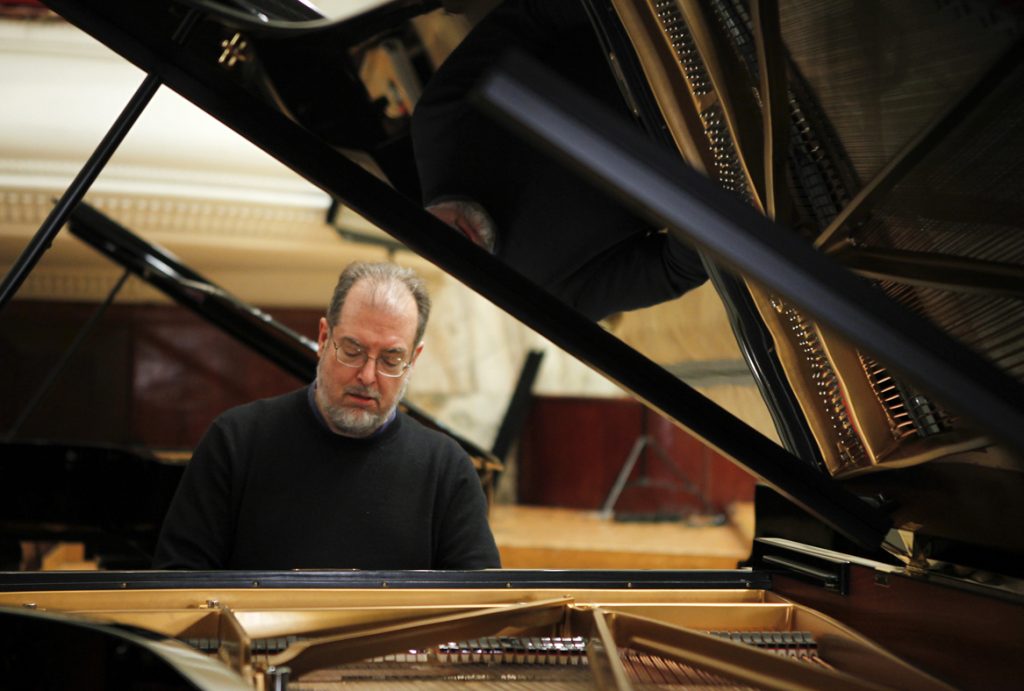Robert Spano Leads the San Diego Symphony in Compelling Lutosławski and Rachmaninoff
Robert Spano, who recently completed his lauded 20-year tenure as Music Director of the Atlanta Symphony Orchestra, conducted the San Diego Symphony Friday at the Rady Shell. Spano’s program balanced the familiar—Rachmaninoff’s Third Piano Concerto—with the less familiar, Witold Lutosławski’s 1954 Concerto for Orchestra and Brian Raphael Nabors’ recent commission from the Atlanta Symphony “Onward.”
Although Lutosławski is one of eastern Europe’s most highly regarded composers from the second half of the 20th century, the San Diego Symphony has paid him scant attention. In 2018, guest conductor Johannes Debut led the orchestra in a shorter Lutosławski work, his Little Suite, but otherwise the highly regarded Pole has been overlooked.Like Bartók’s well-known Concerto for Orchestra, Lutosławski’s work presents a work of serious scope and depth, three movements that engage the entire orchestra in a rewarding virtuoso venture. The first movement opens with grand, pulsing themes marked by a throbbing drum beat that goads the full orchestra into powerful crescendos. Having gained his audience’s full attention, the composer shifts to a stark, quiet section in which the woodwinds offer mysterious arabesques.
Anxious yet animated themes from high-pitched instruments scamper in the middle movement, “Capriccio notturno e arioso,” while bolder themes from the orchestra’s lowest instruments create tense anticipation in the fashion of a bold scherzo. Lutosławski clearly does not abandon tonality as many of his contemporaries in Western Europe did in this post-World War II era, but his use of folk music themes provides modal coloring that expands his harmonic palette. After the strings’ pizzicato dance-like interlude, this movement ends abruptly with quiet drumming.
The heart of this Concerto for Orchestra is its lengthy final movement, “Passacaglia, toccata e corale.” In traditional passacaglia style, the contrabass section introduces the bass theme, a sturdy pizzicato motif, upon which the passacaglia will unfold. Other low-pitched instruments crowd the scene until the English Horn announces a vigorous countersubject, played with her customary authority by Andrea Overturf. When the full string section climbs on board, they give this new subject brazen, martial overtones, which the percussion section amplifies as the passacaglia comes to a majestic climax. In the toccata section, vibrant strings and spirited brass fanfares compete as fragments of the majestic final chorale enter this powerful, driving finale.
Spanos proved a most trustworthy guide for the orchestra in this adventurous score, and he secured from the players a consistently confident—even polished—account of this major work.
Not surprisingly, Sergei Rachmaninoff’s Piano Concerto No. 3 in D Minor, has not been neglected by the San Diego Symphony. In recent years pianists Kirill Gerstein and Behzod Abduraimov have given their accounts of this concerto with the orchestra, so it was about time for the American virtuoso Garrick Ohlsson to weigh in on this popular chestnut from the great Russian Romantic school of concertos.
Spano’s tempo choice for the opening movement, an allegro with just the proper amount of urgency, served well the movement and its main theme, which plays an important role throughout the concerto. I expected Ohlsson’s confident traversal of the composer’s unrelenting and demanding flamboyant cascades, but I was impressed with the elegant cantabile tone he coaxed from the orchestra’s Steinway throughout the lengthy concerto. Rachmaninoff wrote this concerto for himself to play on his 1909-1910 concert tour of the United States, and he gave himself ample opportunity to reveal the extent of both his musical invention and his vaunted keyboard technique.
Principal Oboe Sarah Skuster gave an enchanting account of the solo that opens the wistful Adagio movement, and once the piano finally appeared after an unusually extended introduction, Ohlsson caressed Rachmaninoff’s ardent piano theme that so completely captures his lush, late-Romantic idiom.
Spano urged both orchestra and soloist to indulge fully the grandeur of the Finale as it builds its martial theme and recalls golden moments from earlier sections of the concerto. It would be difficult to imagine a more compelling account of this sumptuous, powerful concerto.
Nabors’ compact but engaging “Onward” offered nattering fanfares poised in static orchestral suspension. Valiant horn calls and swift orchestral glissandos gave this 10-minute piece the excitement of an action movie sound track.
This concert was presented by the San Diego Symphony in The Rady Shell at Jacobs Park on Friday, May 5, 2023. I will be repeated on May 6 in the same venue.

Ken Herman, a classically trained pianist and organist, has covered music for the San Diego Union, the Los Angeles Times’ San Diego Edition, and for sandiego.com. He has won numerous awards, including first place for Live Performance and Opera Reviews in the 2017, the 2018, and the 2019 Excellence in Journalism Awards competition held by the San Diego Press Club. A Chicago native, he came to San Diego to pursue a graduate degree and stayed.Read more…

